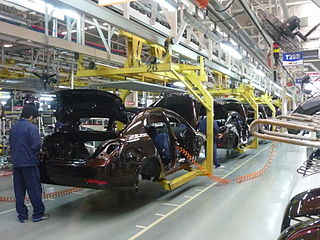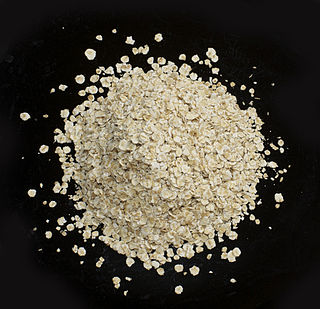
Oatmeal is a type of coarse flour made of hulled oat grains – groats – that have either been milled (ground), steel-cut, or rolled. Ground oats are also called "white oats". Steel-cut oats are known as "coarse oatmeal" or "Irish oatmeal" or "pinhead oats". Rolled oats can be either thick or thin, and may be "old-fashioned", or "quick", or "instant". The term "oatmeal" is also used in the U.S. and parts of Canada as another word for an oat-based porridge popular in such countries made from either ground, steel-cut, or rolled oats.

Ultra-high temperature processing (UHT), ultra-heat treatment, or ultra-pasteurization is a food processing technology that sterilizes liquid food, chiefly milk, by heating it above 135 °C (275 °F) – the temperature required to kill spores in milk – for 2 to 5 seconds. UHT is most commonly used in milk production, but the process is also used for fruit juices, cream, soy milk, yogurt, wine, soups, honey, and stews. UHT milk was first developed in the 1960s and became generally available for consumption in the 1970s.
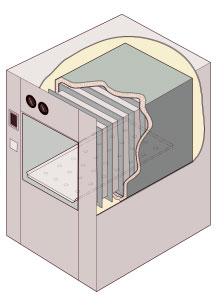
An autoclave is a pressure chamber used to carry out industrial processes requiring elevated temperature and pressure different from ambient air pressure. Autoclaves are used in medical applications to perform sterilization and in the chemical industry to cure coatings and vulcanize rubber and for hydrothermal synthesis. Industrial autoclaves are used in industrial applications, especially regarding composites.

Solar thermal energy (STE) is a form of energy and a technology for harnessing solar energy to generate thermal energy or electrical energy for use in industry, and in the residential and commercial sectors.

The Rankine cycle is a model used to predict the performance of steam turbine systems. It was also used to study the performance of reciprocating steam engines. The Rankine cycle is an idealized thermodynamic cycle of a heat engine that converts heat into mechanical work while undergoing phase change. It is an idealized cycle in which friction losses in each of the four components are neglected. The heat is supplied externally to a closed loop, which usually uses water as the working fluid. It is named after William John Macquorn Rankine, a Scottish polymath and Glasgow University professor.

A fishing trawler is a commercial fishing vessel designed to operate fishing trawls. Trawling is a method of fishing that involves actively dragging or pulling a trawl through the water behind one or more trawlers. Trawls are fishing nets that are pulled along the bottom of the sea or in midwater at a specified depth. A trawler may also operate two or more trawl nets simultaneously.
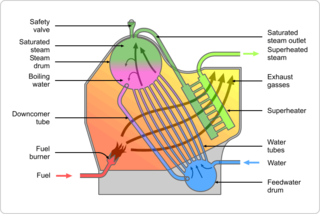
A high pressure watertube boiler is a type of boiler in which water circulates in tubes heated externally by the fire. Fuel is burned inside the furnace, creating hot gas which heats water in the steam-generating tubes. In smaller boilers, additional generating tubes are separate in the furnace, while larger utility boilers rely on the water-filled tubes that make up the walls of the furnace to generate steam.
Steam reforming or steam methane reforming is a chemical synthesis for producing syngas, hydrogen, carbon monoxide from hydrocarbon fuels such as natural gas. This is achieved in a processing device called a reformer which reacts steam at high temperature and pressure with methane in the presence of a nickel catalyst. The steam methane reformer is widely used in industry to make hydrogen, also called "grey hydrogen", from natural gas. With the use of CCUS technology it is possible to capture the carbon dioxide, after which the product will be called "blue hydrogen".
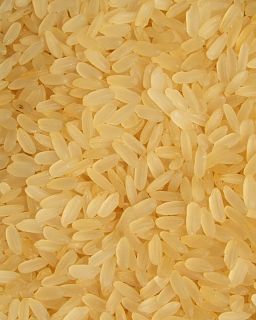
Parboiled rice is rice that has been partially boiled in the husk. The three basic steps of parboiling are soaking, steaming and drying. These steps also make rice easier to process by hand, boost its nutritional profile and change its texture. About 50% of the world’s paddy production is parboiled. The treatment is practiced in many parts of the world such as India, Bangladesh, Pakistan, Myanmar, Malaysia, Nepal, Sri Lanka, Guinea, South Africa, Italy, Spain, Nigeria, Thailand, Switzerland, USA and France.
Drying is a mass transfer process consisting of the removal of water or another solvent by evaporation from a solid, semi-solid or liquid. This process is often used as a final production step before selling or packaging products. To be considered "dried", the final product must be solid, in the form of a continuous sheet, long pieces, particles or powder. A source of heat and an agent to remove the vapor produced by the process are often involved. In bioproducts like food, grains, and pharmaceuticals like vaccines, the solvent to be removed is almost invariably water. Desiccation may be synonymous with drying or considered an extreme form of drying.

A turboexpander, also referred to as a turbo-expander or an expansion turbine, is a centrifugal or axial-flow turbine, through which a high-pressure gas is expanded to produce work that is often used to drive a compressor or generator.
An evaporator is a device in a process used to turn the liquid form of a chemical substance such as water into its gaseous-form/vapor. The liquid is evaporated, or vaporized, into a gas form of the targeted substance in that process.
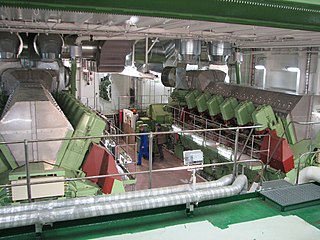
Marine propulsion is the mechanism or system used to generate thrust to move a ship or boat across water. While paddles and sails are still used on some smaller boats, most modern ships are propelled by mechanical systems consisting of an electric motor or engine turning a propeller, or less frequently, in pump-jets, an impeller. Marine engineering is the discipline concerned with the engineering design process of marine propulsion systems.
Heat setting is a term used in the textile industry to describe a thermal process usually taking place in either a steam atmosphere or a dry heat environment. The effect of the process gives fibers, yarns or fabric dimensional stability and, very often, other desirable attributes like higher volume, wrinkle resistance or temperature resistance. Very often, heat setting is also used to improve attributes for subsequent processes.
Abengoa S.A. is a Spanish multinational corporation, which includes companies in the domains of energy, telecommunications, transportation, and the environment. The company was founded in 1941 by Javier Benjumea Puigcerver and José Manuel Abaurre Fernández-Pasalagua, and is based in Seville, Spain with U.S. headquarters in St. Louis, Missouri. It is a global biotechnology company specializing in the development of new technologies in producing biofuels and biochemicals and promoting sustainability of raw materials.
Browning is the process of partially cooking the surface of meat to help remove excessive fat and to give the meat a brown color crust and flavor through various browning reactions. Ground meat will frequently be browned prior to adding other ingredients and completing the cooking process. The process is commonly used when adding ground meat to casseroles or other prepackaged food products like Hamburger Helper, where the final cooking temperature will not be high enough to initiate the Maillard reaction.
Aseptic processing is a processing technique wherein commercially thermally sterilized liquid products are packaged into previously sterilized containers under sterile conditions to produce shelf-stable products that do not need refrigeration. Aseptic processing has almost completely replaced in-container sterilization of liquid foods, including milk, fruit juices and concentrates, cream, yogurt, salad dressing, liquid egg, and ice cream mix. There has been an increasing popularity for foods that contain small discrete particles, such as cottage cheese, baby foods, tomato products, fruit and vegetables, soups, and rice desserts.

Steam is water in the gas phase, which is formed when water boils or evaporates. Steam is invisible; however, "steam" often refers to wet steam, the visible mist or aerosol of water droplets formed as this water vapour condenses. At lower pressures, such as in the upper atmosphere or at the top of high mountains, water boils at a lower temperature than the nominal 100 °C (212 °F) at standard pressure. If heated further it becomes superheated steam.

A waste heat recovery unit (WHRU) is an energy recovery heat exchanger that transfers heat from process outputs at high temperature to another part of the process for some purpose, usually increased efficiency. The WHRU is a tool involved in cogeneration. Waste heat may be extracted from sources such as hot flue gases from a diesel generator, steam from cooling towers, or even waste water from cooling processes such as in steel cooling.

MAN Energy Solutions is a multinational company based in Augsburg, Germany that produces large-bore diesel engines and turbomachinery for marine and stationary applications, as marine propulsion systems, power plant applications and turbochargers. The company was formed in 2010 from the merger of MAN Diesel and MAN Turbo. MAN Energy Solutions is a subsidiary of the German carmaker Volkswagen Group.
